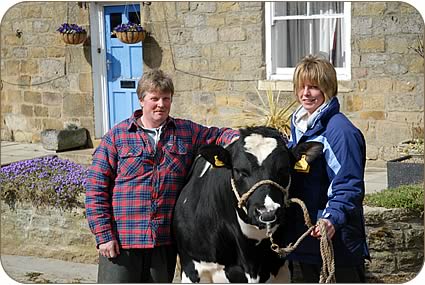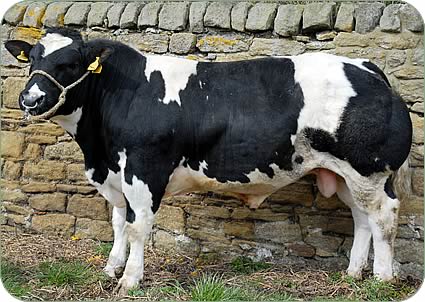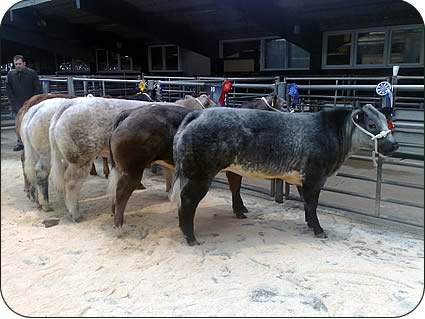Jennifer MacKenzie is an agricultural photo journalist with almost 30 year's experience. Operating from her base in Cumbria, Jennifer undertakes mainly industry-related freelance writing and photography.
In the pink with British Blues
An enthusiasm for breeding pedigree beef cattle and encouraged by prices for cross-bred British Blue suckled calves have led Malcolm Telfer and Helen Claxton to start a new beef venture.
No newcomers to exhibiting cattle having previously shown pedigree Blondes, Malcolm and his partner Helen have started their own pedigree British Blue herd and as a spin-off using their expertise they also run a cattle livery, preparing other breeders’ animals for the show ring.
 |
| Malcolm and Helen on their own and with their bull called Buggerlugs |
Their Newton Blues herd based at Newton, Stocksfield, near Hexham, numbers 15 head which includes two breeding cows and the couple have made their debut in the British Blue show ring this spring and the couple sold their first bull at the Border Club’s sale this May in Carlisle – achieving a creditable 5,000gns.
E Telfer and Sons at Newton High House is also run by Malcolm’s brother David who manages the farm’s 480 arable acres growing oil seed rape, wheat and barley, while Malcolm and Helen look after the livestock side on 280 acres of grassland – the 75 commercial sucklers, the pedigree breeding and a commercial flock of 60 Beltex and Texel ewes.
It was through their shared enthusiasm for cattle and Blondes at the time that Malcolm and Helen met.
The Telfer’s Stocksfield Blonde herd was founded in the early 1980s and Helen’s grand parents own the well-known Totteridge herd in Hertfordshire.
The Stocksfield herd had great success in the show ring with both home-bred and bought in stock and it was after the stock bull Sornfallow VIP cleaned up the championships at the Highland, Royal and Great Yorkshire shows that Malcolm thought he should end showing the cattle on a high note.
The herd also held the record price for a Blonde female in the sale ring at 6,500gns in Carlisle in 1990.
 |
| Newton Blues Buggerlugs |
Now around a dozen pure Blonde cows are kept for commercial calf breeding alongside pure bred Limousins, Limousin and Belgian Blue and some other crosses, most replacements being home-bred.
“We were looking for something different for crossing onto the commercial cows and in 1999 we bought our first Blue bull, Reinbeck Rubin at a year old. We still have him today and he has produced some good quality calves, including around a dozen show calves selling to a top price of £1,800,” said Malcolm.
“The Blue, both in the type of calf produced and the cow, has the main influence on the herd. We think the Blue gives the width, muscle and shape required.”
“We’re still using a Blonde bull but a lot of the cows will have at least two crosses of Blue further back in their breeding. The Blue and the Blonde is a cross that works well together.
“With the current export market, which the majority of our calves sell for, Blondes have a lot of potential as long as breeders get their act together and breed the right type of bull with more muscle and length – the breed already has plenty of height,” added Malcolm.
Newton Blues Candice at 12 months old was the Blue herd’s first show heifer and she collected the reserve female championship at the Border British Blue Club’s annual calf show in February.
It is her half brother Newton Blues Buggerlugs, one of the first calves, which was the first from the herd to be sold at Carlisle in May at 17 months old.
Candice and another heifer Blackie along with 2007-born bulls Ceasar and Casper, which is all black, make up this year’s show team with Malcolm and Helen planning to exhibit at the, Highland and Yorkshire shows.
At the first summer show in 2008, The Northumberland County and the first outing for the Newton Blues team, Candice was reserve female champion and then came reserve breed champion. Her brother Ceasar, also at 15 months old, was reserve male champion.
Candice was reserve breed champion at the Royal Highland Show.
A full ET sister to Candice, Candy was also sold at the Carlisle May sale for 3,600gns at 14 months old.
By using ET they plan to build up numbers quickly to up to 30 calves, probably with only a small nucleus of breeding females.
While conformation and locomotion are primary considerations, breeding values are taken into account, particularly for calving ease with the commercial bull buyer firmly in mind. As well as the herd’s stock bull, Belgian semen is also used including Danseur, Graphite and SJ.
The livery business has developed purely on reputation with as many as 20-plus animals being at Newton High House at any one time.
Both pedigree and commercial cattle are taken in and prepared for the show and sale ring. This includes feeding, training to the halter, clipping and preparing the animal and can also include showing the animal in the ring.
Limousin bulls come in three weeks before the sale – 17 Limousins were prepared for the February Carlisle sale. The average time is between 10 and 12 weeks at Newton.
The couple also calve pedigree cows and pedigree ET calves. All animals have to be tested before they are accepted for livery.
The commercial cows calve in May with the aim of selling calves the following March at nine to 10 months old.
 |
| Line-up at the two-day Carlisle sale in March |
Over the last two years probably as many as 95 per cent of the calves have gone for export, selling mostly through Carlisle and sometimes Penrith.
This year the 40 bullocks and heifers sold so far have averaged £850 a head. A percentage of the heifers are kept as herd replacements.
Cows are wintered on ad-lib silage with calves weaned in December after housing. Calves are fed creep from three to four months old – Malcolm believes this type of cattle benefit from a fairly high protein diet when they are at a young age.
Their buyers have taken some of the calves on to primestock shows with success, including north Christmas shows and Countryside Live in Harrogate.
For the last two years they have shown a reserve champion at the big spring two-day sale of suckled calves at Carlisle. Both were calves bought at only five months old at Hexham Mart’s Tow Law sale from Jean Thompson of Allotment Farm, Castleside.
This year’s reserve champion heifer was sired by an unregistered British blue bull and was purchased for its show potential for £1,900 by Alan Hall of Preston Tillery Farm, Darlington. “We don’t go out to breed a show calf we’re looking for a good, average calf which is more of the export type to make an E grade carcase. It’s a good average not the odd show calf which helps the bank account!”
Malcolm regrets that the strong export trade deprives UK finishers from finishing his cattle. One buyer, Alan Barrnet from Binns Farm, Shap, finishes the cattle at about 18 months old weighing 700kg and he regularly tops Wigton’s primestock market.
An added benefit is the cast cow trade for the type of cows from Newton with prices this year ranging from £900 to £1,100 a cow sold through Hexham – however, increasing demand for beef breeding cattle has meant replacements are relatively even more expensive.
The farm’s sheep flock is run very commercially but with the same criteria as the cattle – good legs and skin with plenty of meat. The ewes are lambed at the end of March-beginning of April.
Rams are sold through Hexham mart and even in last year’s poor trade they averaged £500 which was around £100 down on previous years. Females are kept as replacements, 10% of lambs are culled and some are sold on for breeding.

